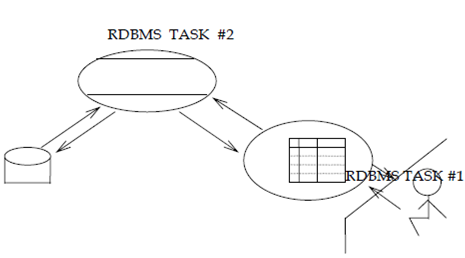Distribution of processing in client/server model
The previous sections discussed about the database and the system which is needed to operate on the database and the most popular system of present like the RDBMS.
The RDBMS acts as a very good interface among you and processes and the database data as per your instructions. An Instruction comes to the RDBMS through way of commands and other interface specific operations. The RDBMS performs the subsequent two distinct tasks or operations when you operate with it:
•Gets the commands from you using a friendly displays the results and user interface by friendly reporting
• Processes the commands given through you and processes data subsequently based on the commands
The Figure description these operations of the database system

DATABASE YOU
Figure: Different operation for a database
Task #1 receives commands through a highly user-friendly interface and interacts with the user sends the commands to task #2 and displays the results which is obtain from task #2 with highly user-friendly reporting facilities. Task #2 processes the data and sends the results to the task #1 and processes the commands and as per the instructions.
This way of processing where the whole job processing is done by two processes that are one working as a front-end and the other working as a back-end is known as Client-Server Model and the database system which works on this architecture is known as Client-Server System. Task #1 is known as Client since it always requests for the command to be processed and it works as a front-end in the whole system. Task #2 is known as Server since it serves the requests of task#1 through way of processing the commands provided.
Clients always interact with the servers and end-user always interacts with the database files and the vice-versa is not possible. The server and the client interact with each other to efficiently do the database processing as requested through the end-user.